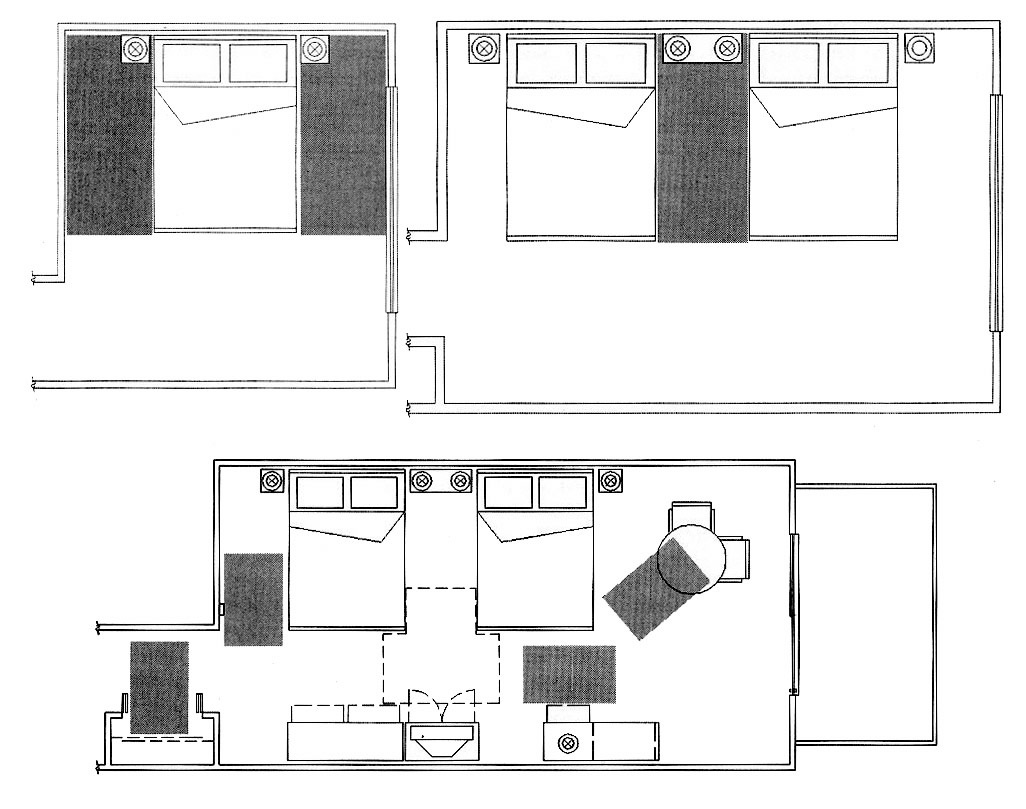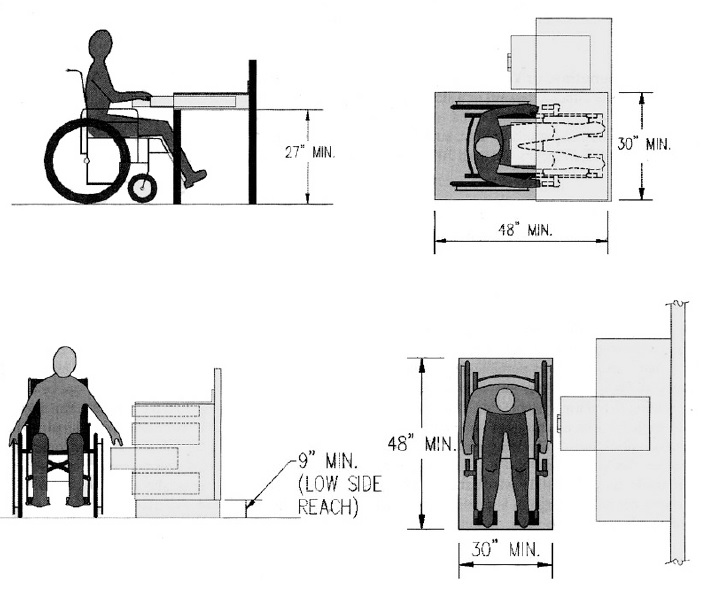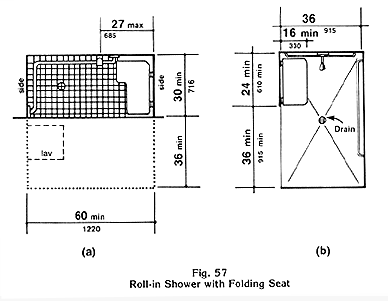Requirements for Accessible Units, Sleeping Rooms and Suites [9.2]
Bedside Clearance [9.2.2(1)]
Where one bed is provided in a room, maneuvering space at least 36 inches wide is required on both sides of the bed. If two beds are provided, this maneuvering space is required only between the beds. Note that the requirement for an accessible route to accessible elements and spaces may result in a 36 inch clearance on the other side of double beds nonetheless.

Clear floor space is required at accessible controls and elements (e.g., thermostats), storage facilities (e.g., closets), and should be provided at non-fixed furnishings (e.g., dressers, tables). An accessible route must connect with the clear floor space. Turning space can overlap required clear floor space, including bedside clearances.
Accessible Route [9.2.2(2)]
An accessible route at least 36 inches wide must be provided to all accessible elements, including phones and thermostats, provided for use by room occupants, fixed or built-in storage facilities required to be accessible (closets, drawers, cabinets), and other spaces required to be accessible (living area, dining area, at least one bathroom and sleeping area, and patios, terraces or balconies, and carports, garages or parking spaces). Recommendation: ADAAG does not address furniture, but it is recommended that where dressers are provided, clear floor space should be provided so that people using wheelchairs can access dresser drawers.
Doors [9.2.2(3), 9.4]
Compliance with 4.13 is required for all doors and doorways designed to allow passage into and within all sleeping suites or other units required to be accessible. Recommendation: An additional peephole in the door for people who use wheelchairs or who are of short stature is not required but may be desirable especially if one offering a wide angle view of the hallway or exterior is used.
Because of the social interaction and visitation that often occurs in lodging facilities, an accessible door clear opening width (32 inches minimum) is required to and within all sleeping rooms and suites, even to those rooms not required to be accessible. This applies to all doors, including bathroom doors, that allow full passage.
Storage [9.2.2(4)]
At least one of each type of fixed or built-in storage facility (cabinets, shelves, closets, drawers) provided in accessible spaces must be accessible as specified in 4.25. "Type" refers to the design of the element (shelving, cabinets, closets) as well as the intended use (coat closets and supply closets). Additional storage elements of the same type are not required to comply.
Clear floor space for either a forward or side approach is allowed. However, since people who use wheelchairs may not be able to reach much beyond the toes, a forward reach is generally limited to those storage elements providing knee and toe clearances. Otherwise, space should be provided for side approaches.

Controls [9.2.2(5)]
All controls in accessible units, sleeping rooms, and suites must comply with 4.27, which provides specifications for clear floor space, height of operable controls, and operation (see pages 96 and 97). These requirements apply primarily to those controls and operating mechanisms intended for use by patrons; those used only by employees and facility operators for purposes of maintenance or repair and similar purposes (electrical outlets for cleaning equipment, refrigerators, and clocks, etc.) are not required to comply.
Accessible Spaces [9.2.2(6)]
Where provided in accessible units, sleeping rooms, or suites, the following spaces are required to be accessible and be on an accessible route: living areas, dining areas, at least one sleeping area, patios, terraces, or balconies, bathrooms, and carports, garages, or parking spaces.
Bathrooms
Accessible bathrooms must provide an accessible water closet, accessible lavatory, and accessible shower or tub. If only half baths are provided, accessible fixtures are required in at least the one half bath required to be accessible. ADAAG allows provision of either tubs or showers in most accessible rooms. Some rooms in larger facilities must have a combination roll-in/ transfer shower. ADAAG covers several types of shower stall designs: roll-in, transfer, and, in hotels, a combination of the two. Typically a shower chair, a mobility aid more suitable for bathing than standard wheelchairs, is used with roll-in showers. Roll-in showers are most practical where shower chairs can be made readily available or where people may stay for extended periods (dormitories, dwelling units). The required folding seat in combination roll-in/ transfer showers offers greater flexibility by allowing transfer as well, particularly for people traveling without a shower chair. Two types of design for this combination shower are provided in ADAAG (Figure 57).

Kitchens, Kitchenettes, or Wet Bars [9.2.2(7)]
Clear floor space for either a forward or a side approach is permitted for cabinets, counters, sinks, and appliances. A forward approach to sinks (with knee and toe clearances below) is recommended for sinks that may be used more regularly or for extended periods of time, such as a kitchen in apartment-style dormitories. Counter tops and sinks may be no higher than 34 inches. At least 50% of refrigerator and cabinet shelf space must be within the reach ranges specified in 4.2.5 or 4.2.6.
Accommodations for Persons with Hearing Impairments [9.2.2(8)]
Accessible rooms or suites must also provide accommodations for people with hearing impairments (visual alarms and notification devices, volume controls on permanently installed telephones, etc.). This is required in order to accommodate a person (or couple or family) who needs both types of access. Additional portions of rooms or suites are required to provide accommodations only for persons with hearing impairments.

User Comments/Questions
Add Comment/Question